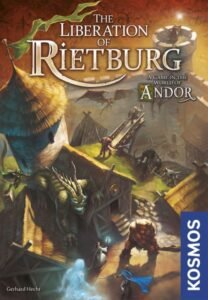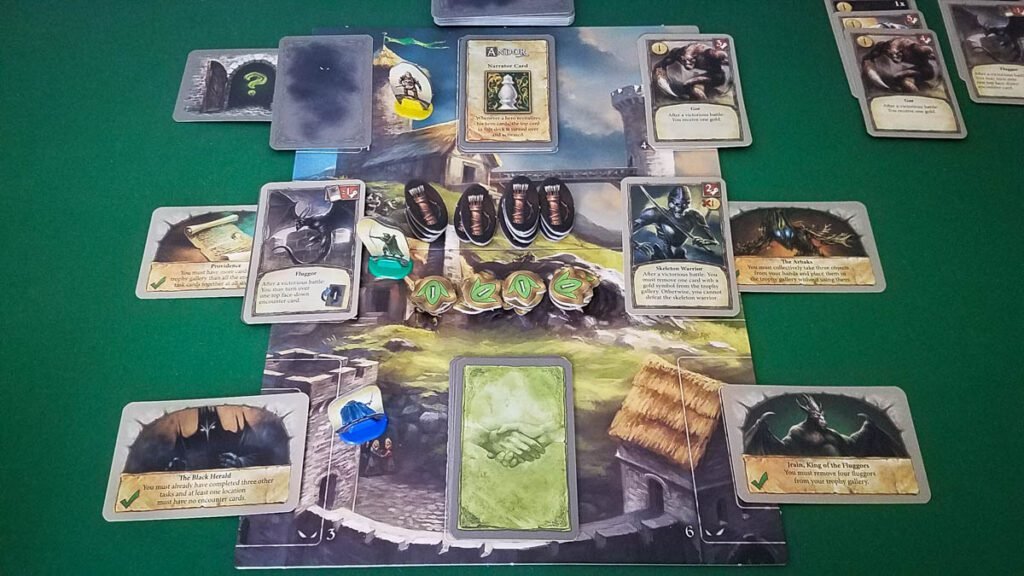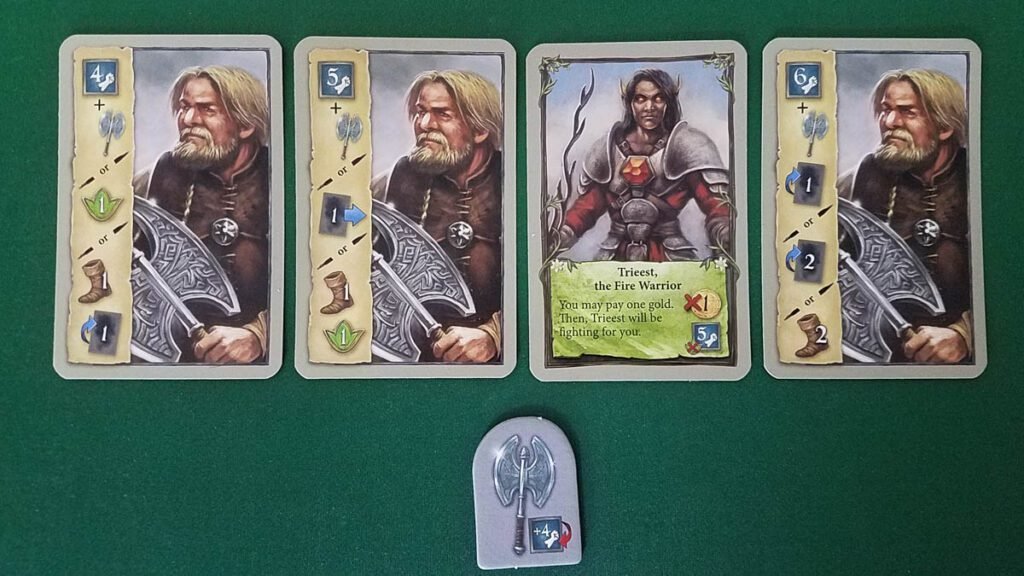The Liberation of Rietburg Review
Year: 2020 | Players: 2-4 | Minutes: 40 | Ages: 10+
This The Liberation of Rietburg review was made after playing the game six times. We were sent a copy of this game by the publisher in exchange for an honest review.
What is The Liberation of Rietburg?
The Liberation of Rietburg is a cooperative tower defense card game in which you play as heroes who are attempting to regain control of their castle, which has been taken over by some evil creatures. The game is set in the same world as Legends of Andor.
The Liberation of Rietburg was designed by Gerhard Hecht and it is published by KOSMOS.
Rules Overview
In The Liberation of Rietburg, you’ll be sending your heroes to six locations around your city to fight enemies, pick up some helpful items, and complete tasks. The Task cards’ objectives can range from defeating certain types of enemies to making sure that there aren’t too many Encounter cards at the locations. Your goal is to complete four of the six tasks before time runs out.
At the start of the game, each of the locations will have a face-down Task card. During setup and throughout the game, you’ll draw Narrator cards that will tell you where to place new Encounter cards, which are put face-up or face-down on top of the Task cards. You need to work your way through those encounters by fighting the enemies and picking up the items so you can flip the Task cards.
You have two main options on your turn: play a card or pick up your previously played cards. When you pick up your cards, you have to draw a Narrator card, which adds two more Encounters to the board. There are also some free actions, including revealing face-down Task cards, completing tasks, and picking up objects/items at your location.
Most of the heroes have three cards (one hero has four) and most turns you’ll be using one of your cards to take actions. Each Hero card has three action options and you’ll choose one of those options each turn. For example, you could use a card to flip over an Encounter card and then fight an enemy, or you might pull an enemy from another location to yours. All of the heroes’ cards have different sets of actions and they also have unique abilities, such as Kheela’s Water Spirit that she can send to a location to give all of the heroes combat bonuses. You’ll also possibly get Object and Friend cards during the game, which give you new abilities and more cards to work with on your turn.
To defeat an enemy, you have to match or exceed their Battle Strength with the Battle Strength on your card. If another hero is at your location, they can play a card to add to your Battle Strength, which is the best way to take down some of the larger creatures. Defeated enemies give you rewards, such as gold, Friend cards, and the ability to instantly remove a face-down Encounter card.
You’ll beat the game if you complete four tasks. You’ll lose if you need to draw a Narrator card and there are none left in the deck or if you need to draw an Encounter card and there are none left in that deck.
Pros and Cons
Pros
- The Liberation of Rietburg has a simple and fun hand management/action selection system. Most heroes only start out with three cards, so you want to get the most out of those cards before you have to add more encounters to the board. It also feels great when you get to add Friend and Object cards to your hand because they give you even more options and slow the enemies down. A lot more strategy goes into it than I expected.
- It’s pretty cool that you don’t know what your objectives are until you reveal those Task cards. It gives the game a unique buildup and it forces you to adjust your strategy on the fly. Plus, you only use six of the 12 Task cards every game, which adds to the game’s replayability.
- This game also requires a high amount of cooperation, which is always a good thing. Throughout the game you have to talk about what your hero can do to help the team and how your teammates might be able to set you up. You can’t just do your own thing with no communication and expect to win.
- I’m a big fan of games that let you team up in combat, and it’s really straightforward and fun in The Liberation of Rietburg. What I didn’t point out in the gameplay overview is that you can use your Move actions to move other heroes to your location, which is a cool way to set up those group battles.
- The six heroes are pretty similar, but their main abilities are enough to make them all feel different to play. I’ve played with all of them and I’ve had to approach the puzzle in a slightly different way each time.
- I wouldn’t call this a high-suspense game, but there’s a good amount of tension when you draw those Narrator cards. You pretty much always have more interest in clearing out certain locations over others, so you definitely do care about what you draw from that Narrator deck.
- It’s great that there are multiple ways to adjust the difficulty. The game is challenging regardless, but you can simply add in more challenging enemies and/or put fewer Narrator cards in the deck to make the game tougher.
- I’m a huge fan of the art that Michael Menzel has created for all of these games set in Andor. None of the art in this game compares to the boards he made for Legends of Andor and its expansions (that’s some of my favorite board game art), but these cards and the board look great.
Cons
- The creatures really aren’t that interesting. I get that the game was designed to be more of an abstract puzzle rather than a thematic experience, but it’s weird that none of the creatures have abilities or rewards that make thematic sense. Most of them just give you gold or have you flip over other Encounter cards.
- I think the game needs more Object cards. There are only eight of them and they all get shuffled in the Encounter deck each game, so there really aren’t any surprises in that deck. It would have been great if there were 16 of them and a random eight were shuffled in each game.
- The rulebook is organized in a pretty strange way. For example, the rules for battling are in the “Additional Rules” section near the back of the book instead of in the “Course of Play” section. It’s not a complex game, though, so it’s not that big of a deal.
Final Thoughts
I’ve had a lot of fun playing The Liberation of Rietburg, which doesn’t really surprise me because I generally enjoy playing lightweight co-op puzzle games. That hand management system is really cool, I like having different tasks to complete each game, and it’s a good challenge even at the lowest difficulty level. I don’t know if it will go into my filler game rotation, but I am going to keep it in my collection for now because I think it’ll work great as a gateway game.
As far as player counts go, I think it’s best as a three or four-player game. It works fine at two, but I like having more heroes to combo with and I think the puzzle is a bit more interesting with more players.
If you’re a fan of lighter cooperative games, you’ll probably like The Liberation of Rietburg. If you also happen to enjoy playing puzzle games, I’d definitely recommend this one. Just don’t expect it to play like Legends of Andor since, other than being set in the same world, they play pretty differently.
The Liberation of Rietburg Links
BGG | Amazon
Thanks for taking the time to read our The Liberation of Rietburg review!
To stay updated on all things cooperative board games, follow us on Twitter, Facebook, or via RSS.



